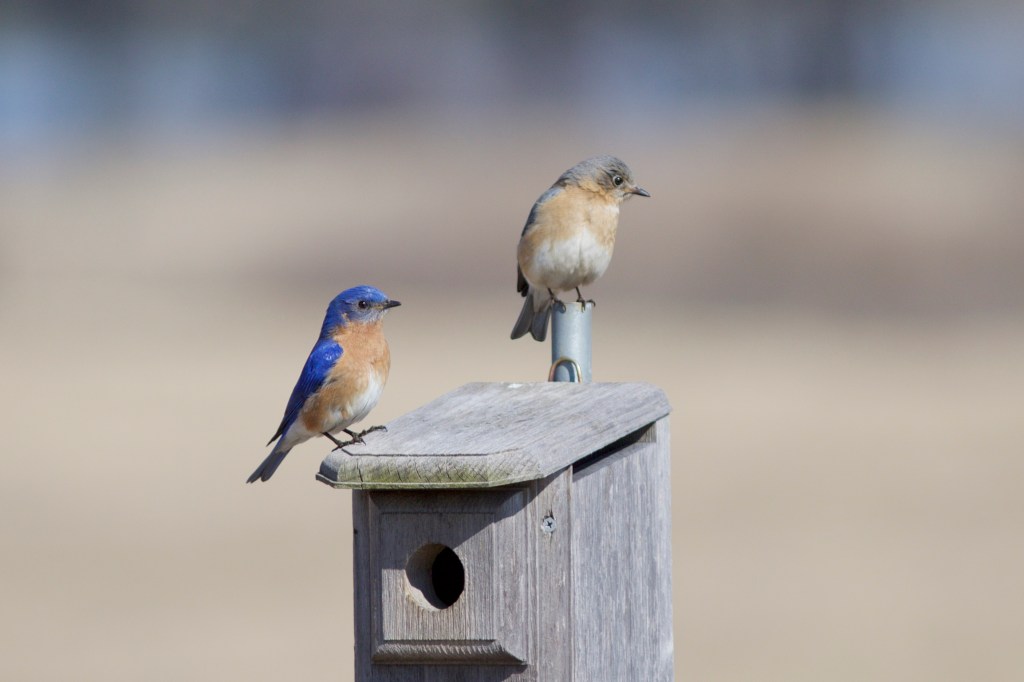
Note: This article deals with avian mortality and interspecies aggression.
With leaves falling from the trees, many people are getting in all the outdoor winter preparations around their yard before the days get too short and the first snow arrives. One great thing you can do is clean out your bird houses (more on this later). It was while doing this, however, that Ben Niles of South Freeport made an unfortunate discovery of a deceased Eastern Bluebird with eggs still in the nest. This naturally prompted many questions, and that’s what I’ll break down here along with a few tips for your yard prep.
Let’s start with the why: Why would there be a dead bird in a bird house, especially with its eggs? Unfortunately, a common problem for cavity nesting species comes from competition with non-native species that also want to use those cavities, in this case, a bird house. The most common culprit is the house sparrow, also known as the “English sparrow” because they are an Old World species. They are very aggressive and will go into an occupied box and peck the adult bluebirds to death. Ben didn’t mention if there was any other material added to the box, which is typically the house sparrow’s next move: build its own nest on top of the deceased bluebirds.
House sparrows, and other non-native cavity nesting species, like European starlings, have become a major problem for our native birds in terms of competition for nesting resources. This is especially alarming since it has been less than 200 years since house sparrows were introduced to North America. They were first introduced in New York in 1850, and Portland was the second city to have them released, in 1854. A great resource for all things bluebirds and advice on house sparrow management is sialis.org.
It is worth noting that even native species will compete with bluebirds and sometimes show quite aggressive behavior, properly called “agonistic behavior.” Tree swallows are perhaps the most common species to see competing with eastern bluebirds for nesting sites in the spring, and while they can outcompete bluebirds, it rarely turns lethal, as we see with house sparrows.
Another nasty nesting neighbor is the house wren. When males move into a territory, they will claim as many cavities as they can by filling them with sticks. Then, once the female arrives, she’ll pick which cavity she wants to nest in and they will build an actual nest together. If bluebirds are already nesting, wrens are well known for going in and puncturing the eggs of a bluebird (accounting for one-third of the nest predation, in a Michigan-based study). Before moving on from agonistic behaviors, it is worth mentioning that bluebirds can be pretty aggressive, too, not only to other bluebirds, but also in evicting other native species from cavities.
Enough talk of death and destruction. Another side of Ben’s situation you may be curious about is whether or not you should be cleaning out your bird houses. This is a perennial question, and one that we often get in the spring as people wonder if they’ve missed an opportunity to clean them out because birds have already returned. The easy answer is yes, clean them out and give birds a fresh start next year. Many parasites, especially mites, move into old nest material, so removing those is helpful. We see many rodents, especially field mice, move into the boxes on Maine Audubon sanctuaries, which isn’t a bad thing. They’ll use the boxes either for their own shelter or also to store food, and better to have them do that outside than trying to move into your house. But also, keep in mind that birds have been around for 65 million years (150 million if you include the Cretaceous birds), and bird houses have only been around for a few hundred years. There weren’t any humans cleaning out nesting cavities for all those millions of years prior, so if you don’t get to it, don’t worry, the birds will be fine without us.
I’ll wrap up with the reminder that many birds and other wildlife are also prepping for winter right now, and there are things you can do in your backyards to help. The easiest is to “leave the leaves,” as many critters, especially insects (many moths and butterflies) and some amphibians use leaves as an insulating shelter in the winter. At least leave what you can; I’ll be cleaning up around my driveway and woodshed because I’ll need to use that space this winter, but the rest of our yard (and especially where I’ve been planting native plants) won’t be used again until spring. The yard won’t benefit at all from me raking leaves, but dozens of overwintering insects and animals will.
Have you got a nature or wildlife question of your own? It doesn’t have to be about birds! Email questions to [email protected] and visitwww.maineaudubon.org to learn more about birding, native plants, and programs and events focusing on Maine wildlife and habitat. Maine Audubon Staff Naturalist Doug Hitchcox and other naturalists lead free bird walks on Thursday mornings starting at 7 am, at Maine Audubon’s Gilsland Farm Audubon Sanctuary in Falmouth.
NOTE: No walk on Thanksgiving, and in December the walk start time changes to 8 am.
We invite you to add your comments. We encourage a thoughtful exchange of ideas and information on this website. By joining the conversation, you are agreeing to our commenting policy and terms of use. More information is found on our FAQs. You can modify your screen name here.
Comments are managed by our staff during regular business hours Monday through Friday as well as limited hours on Saturday and Sunday. Comments held for moderation outside of those hours may take longer to approve.
Join the Conversation
Please sign into your CentralMaine.com account to participate in conversations below. If you do not have an account, you can register or subscribe. Questions? Please see our FAQs.